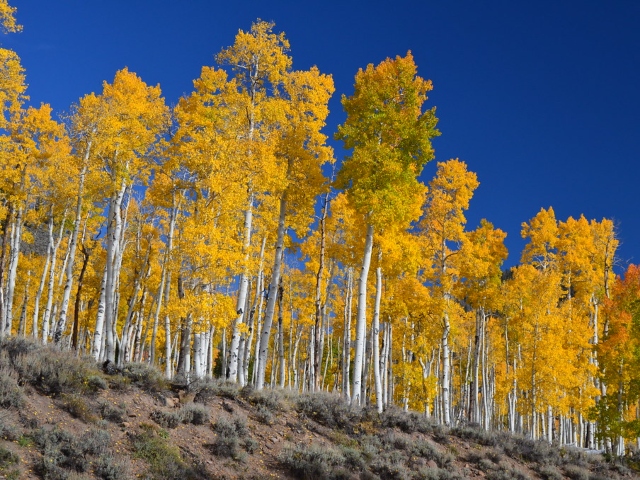
-
Haunting Sounds Of The World’s Largest Living Thing Recorded By Scientists
20 Oct 2023 by Heinrich in Environment, Nature, Tech/Sci, World
[imagesource:flickr]
Pando, or “I spread” in Latin, is a single tree that has grown into a forest covering 40 hectares of Utah with 47,000 stems (all with the same DNA). This single male quaking aspen (Populus tremuloides) has slowly developed into 6,000 metric tons of gigantic life.
We can now hear one of the largest and most ancient living organisms on Earth whisper as the trembling of a million leaves echo through its roots.
Sound artist Jeff Rice experimentally placed a hydrophone inside a hollow at the base of a branch and threaded it down to the tree’s roots, not expecting to hear much. But the massive 12,000-year-old tree, whose stems tower up to 24 metres into the air has a lot to say after all this time.
“The findings are tantalizing,” Lance Oditt, founder of Friends of Pando, said when the project was unveiled in May. “While it started as art, we see enormous potential for use in science. Wind, converted to vibration (sound) and travelling the root system, could also reveal the inner workings of Pando’s vast hidden hydraulic system in a non-destructive manner.”
“Hydrophones don’t just need water to work,” Rice said. “They can pick up vibrations from surfaces like roots as well, and when I put on my headphones, I was instantly surprised. Something was happening. There was a faint sound.”
During thunderstorms, the sound increases, and Rice’s device has now captured the eerie low rumbling.
When presenting his recordings to the 184th Meeting of the Acoustical Society of America, Rice said “What you’re hearing, I think, is the sound of millions of leaves in the forest, vibrating the tree and passing down through the branches, down into the earth.”
Even though tapping on a branch at a distance of 30 metres was not audible via the air, the hydrophone managed to pick up the sound. This proves the idea that Pando’s root system is interconnected. Such shared root systems are common in colonial quaking aspens, but the size and age of Pando make it unique.
While quaking aspens can reproduce through seeds, they seldom grow from them as pollination is rare since large aspen groves are usually only one sex, being clones of the same plant.
Friends of Pando invited Rice as an ‘artist in residence’ to try and better understand this strange, enormous entity.
“The sounds are beautiful and interesting, but from a practical standpoint, natural sounds can be used to document the health of an environment,” said Rice. “They are a record of the local biodiversity, and they provide a baseline that can be measured against environmental change.”
Sadly, this magnificent tree is deteriorating, leaving researchers worried that Pando’s days – and all the forest life it supports – are numbered. Human activities, including clearing and killing predators that keep down herbivore numbers, are eating away at this ancient living being.
We might not have long to listen to the secrets of ‘The Trembling Giant’.
[source:sciencealert]
Latest News
-
Friday Morning Spice
[imagesource:FMT] Outrage And Hope As ICC Issues Warrants For Netanyahu, Gallant And Deif...
-
Thai Woman Sentenced To Death For Murdering 14 Friends With Cyanide In Shocking Killing Spree
[imagesource: Sararat Rangsiwuthaporn] A woman in Thailand, dubbed 'Am Cyanide' by Thai...
-
René Magritte Painting Sells For Record R2.1 Billion At Auction
[imagesource:renemagritte.org] A René Magritte painting portraying an eerily lighted s...
-
Brave Rape Survivor Alison Botha Faces New Challenge After Brain Surgery
[imagesource: Alison Botha] Gqeberha rape survivor Alison Botha, a beacon of resilience...
-
Get Ready For The Mother of All Celebrations As MCQP Turns 30
[imagesource:mcqp/facebook] Clutch your pearls for South Africa’s favourite LGBTQIA+ ce...
-






























